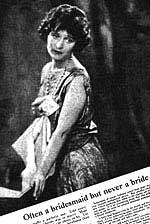
In the early half of the twentieth century, the makers of Listerine had a problem. Their amber-colored concoction tasted terribly (a competitor would later use the euphemism “medicine-y” to describe its unpleasant flavor). How, company officials wondered, could they possibly convince consumers to purchase such a foul-tasting mouthwash?
 Fortunately for Listerine’s future, its marketers understood our innate human tendency to focus on negative information. Hence, the company invented a forbidding-sounding condition they named halitosis—better known today as bad breath—and ran advertisements aimed at convincing the American public of its social consequences.
Fortunately for Listerine’s future, its marketers understood our innate human tendency to focus on negative information. Hence, the company invented a forbidding-sounding condition they named halitosis—better known today as bad breath—and ran advertisements aimed at convincing the American public of its social consequences.
In one memorable Listerine print ad that appeared in the 1920s, copywriters recounted the tragic circumstances of “Pathetic Edna.” Readers were expected to consider Edna’s story sad because of her marital status: she was, after all, nearly 30 years old and still unmarried. What’s more, because of her halitosis, Edna had to be content being “a bridesmaid but never a bride.”
Thanks to Edna’s unenviable saga—and an intrinsic propensity researchers now call negativity bias—sales of Listerine soared from $100,000 in 1921 to over $4 million in 1927.
——————————————————————–
 L2L Suggestion Box
L2L Suggestion Box
>>> Send in your ideas for L2L Blog Topics for 2010. Suggest Here<<<
Sponsored by GrowthSource
——————————————————————–
Negativity Bias
In 1998, John Cacioppo led research at Ohio State University testing the hypothesis that negative information stimulates our brains more than positive stimuli does. Cacioppo showed college students a series of photographs expected to arouse positive, negative, or neutral feelings. Using EEGs to monitor electrical movement in his subjects’ brains, Cavioppo found greater electrical activity occurred during those moments when students viewed pictures inducing negative thoughts.
Simply put, we have a negativity bias.
Negativity bias is tied to our inherent response system that prepares us to fight or flee whenever danger is apparent. That explains why employees pay closer attention to negative information they garner from coworkers than they do good news delivered by the boss. The boss said we’re getting raises, but I hear they won’t be as big as last year.
Therefore, rather than a characteristic of problem employees—or a symptom of poor leadership—negativity is human nature at work.
Can understanding negativity bias help you lead your employees? I think so. For example, you can use negativity bias when trying to drive change. Instead of reciting the positive selling points of the change you’re making (“The new timekeeping system will streamline payroll processing…”), point out the negative pitfalls of maintaining the status quo (“The current payroll system is so unreliable, I’m afraid we might not get paychecks produced on time someday…). No paychecks? Now that’s pathetic.
Don’t let negativity at work leave a bad taste in your mouth. Make it work for you.
Add to: Facebook | Digg | Del.icio.us | Stumbleupon | Reddit | Blinklist | Twitter | Technorati | Yahoo Buzz | Newsvine
———————————————————————-
George Brymer is author of Vital Integrities and the creator of The Leading from the Heart Workshop®.
He can be reached at [email protected]
Image Sources: whatwegrow.blogspot.com, nzgirl.co.nz
